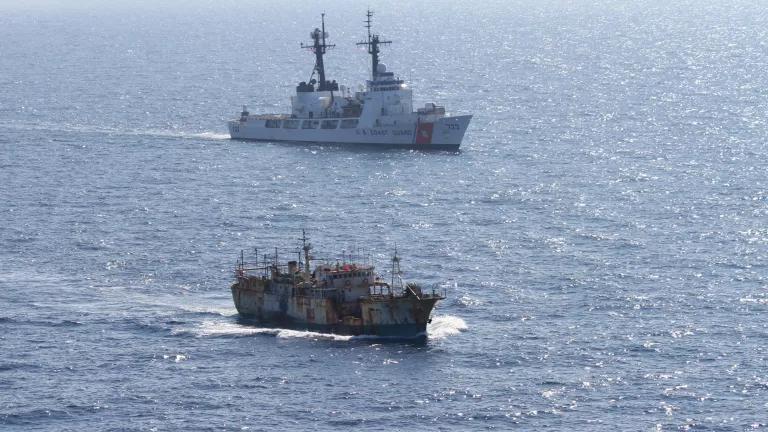Treaty on Wildlife Trade Washes its Hands of COVID-19
CITES should be among those leading, not avoiding, an effective global response to the COVID-19 crisis.

Caged monkeys at the Pramuka Burung Market, the largest bird market in the country, in Jakarta, Indonesia.
Learn more about NRDC’s response to COVID-19.
CITES should be among those leading, not avoiding, an effective global response to the COVID-19 crisis.
The COVID-19 crisis, which has impacted the health and safety of communities across the world, is a direct result of exploitation and trade in wildlife.
There is one international treaty—signed by 183 countries—that could be used to address wildlife trade and help prevent zoonotic pandemics in the future: the Convention on International Trade in Endangered Species of Wild Fauna and Flora (CITES).
Unfortunately, the body in charge of administering the treaty, the CITES Secretariat, has expressed little interest in employing the treaty’s provisions to help prevent the spread of zoonotic viruses, preferring instead to support calls for maintaining the status quo that got us into this mess in the first place.
In March, Ivonne Higuero, the recently-installed CITES Secretary-General, issued a clear and definitive statement on the COVID-19 crisis: “Matters regarding zoonotic diseases are outside of CITES’s mandate, and therefore the CITES Secretariat does not have the competence to make comments regarding the recent news on the possible links between human consumption of wild animals and COVID-19.”
Read: Not our problem.
But, despite her initial statement, the Secretary General is commenting. She has taken to Twitter now several times to support calls for doing…essentially nothing, at least nothing new or different that can help us adapt to our changing world. While the rest of the planet is recognizing the growing need to eliminate trade in wildlife for our own health and safety, not to mention to reverse its devastating impact on biodiversity, Secretary-General Higuero is tweeting her opposition to calls for far-reaching bans on wildlife trade.
The fact is, the Secretariat rarely misses an opportunity to talk about the impacts that curbing trade may have on livelihoods and economic development but won’t talk about the impacts that not curbing trade may have on livelihoods and economic development, not to mention global health. Others have noticed as well, leading them to question whether CITES has any utility at all in this new world.
Unfortunately, the Secretary-General’s anemic statements regarding the COVID-19 crisis track with previous statements from the CITES Secretariat about the global biodiversity crisis overall, the dire nature of which was illuminated in May, when the Intergovernmental Science-Policy Platform on Biodiversity and Ecosystem Services (IPBES) released its Global Assessment Report.
The report warns that we could lose about 1 million species, many in the next few decades, if we continue with business-as-usual. Direct exploitation, including international trade, is a top driver of the biodiversity crisis, according to the report, and it will take “transformational change” to reverse the devastation.
However, business-as-usual seems to be the mantra of the Secretariat. For example, the Secretary-General said recently that the current CITES objectives, agreed to years ago, were enough to address the direct exploitation of wildlife, and that more ambitious goals aren’t necessary.
According to Secretary-General Higuero, maintaining the status quo and just meeting current obligations is “transformative change.” As she said recently at the United Nation’s World Wildlife Day celebration, “If you ask me what transformative change means, I would say: it is when all relevant stakeholders fully meet their international environmental obligations and commitments.” And, she reinforced this notion in a recent interview with the UN Environment Programme, emphasizing the need to address illegal wildlife trade (which is already banned) and continue using wildlife sustainably, with no mention of the fact that legal, sustainable wildlife trade is as risky, if not riskier, than illegal, unsustainable trade.
Fortunately, we don’t have to ask her. The 145 preeminent experts who are studying the biodiversity crisis for IPBES have concluded that the transformative change we need to secure the ecosystems on which we depend is a “fundamental, system-wide reorganization across technological, economic and social factors, including paradigms, goals and values.”
To be fair, CITES is not an all-encompassing biodiversity conservation tool that some make it out to be. It is designed to address the specific threat that international commercial trade can pose to wild species. But it could nonetheless be used in new and inventive ways to help address the biodiversity crisis and the resulting COVID-19 pandemic that threatens our own species, while still staying true to its purpose and mandate.
For starters, the Parties, with support from the Secretariat, could use the IUCN Red List of Threatened Species and other resources to identify and protect the thousands of species that are threatened with extinction and possibly impacted by trade and are either unprotected or under-protected by CITES. And, they could close compliance loopholes; properly resource and support enforcement in biodiversity-rich developing countries; and hold importing countries in the developed world, who have more resources and capacity to address wildlife trade, accountable for their roles in driving the destructive trade in the first place.
In short, CITES could much more effectively regulate or prohibit international commercial trade in a much larger variety of species, instead of just a select few, leaving it to countries to further restrict imports and exports, close domestic markets for wildlife, and take other important measures. And it could be done in a way that protects the lives and livelihoods of local communities and indigenous peoples and helps them transition to more sustainable and resilient, and less dangerous, means of economic development.
Instead of hiding behind the minority of Parties and special interests who are actually advocating for increasing the exploitation and trade of wild species in this time of mass extinction and global pandemic (caused in part by the exploitation and trade in wild species), the CITES Secretariat should be challenging the CITES Parties to help bring about the transformative change we need. It should be asking the Parties to do more, not less. It should be asking the Parties to increase their level of ambition, not take a last-century approach to conservation. Then, maybe, CITES can play a key role in reversing the biodiversity crisis and helping to stop its most harmful impacts, like future zoonotic pandemics.
CITES itself was transformative when it was adopted almost 50 years ago, and it could be again. But it will take real leadership and a new paradigm that asks not what Parties have been willing to do in the past, but what they must do in the future to reverse the biodiversity crisis.



